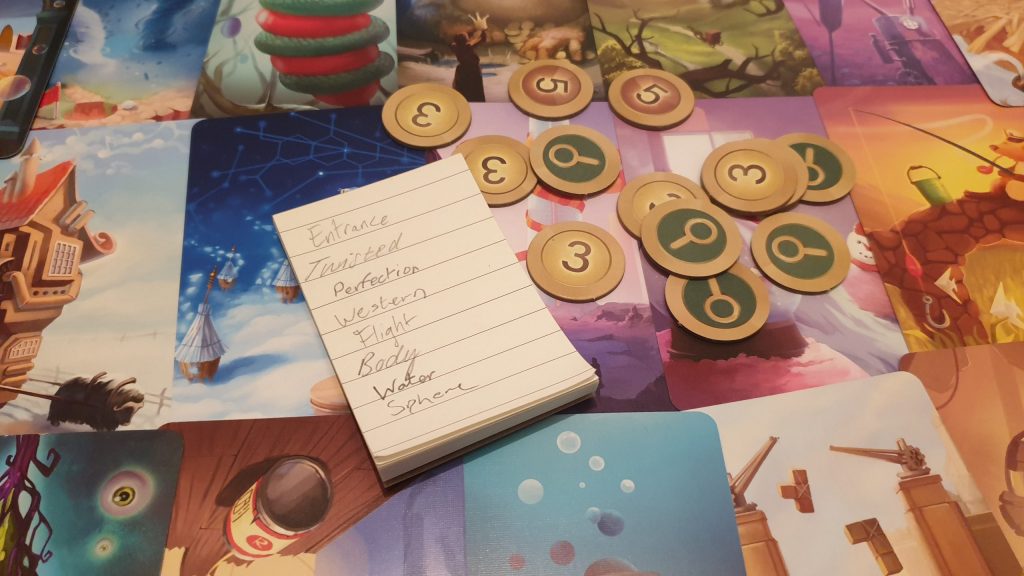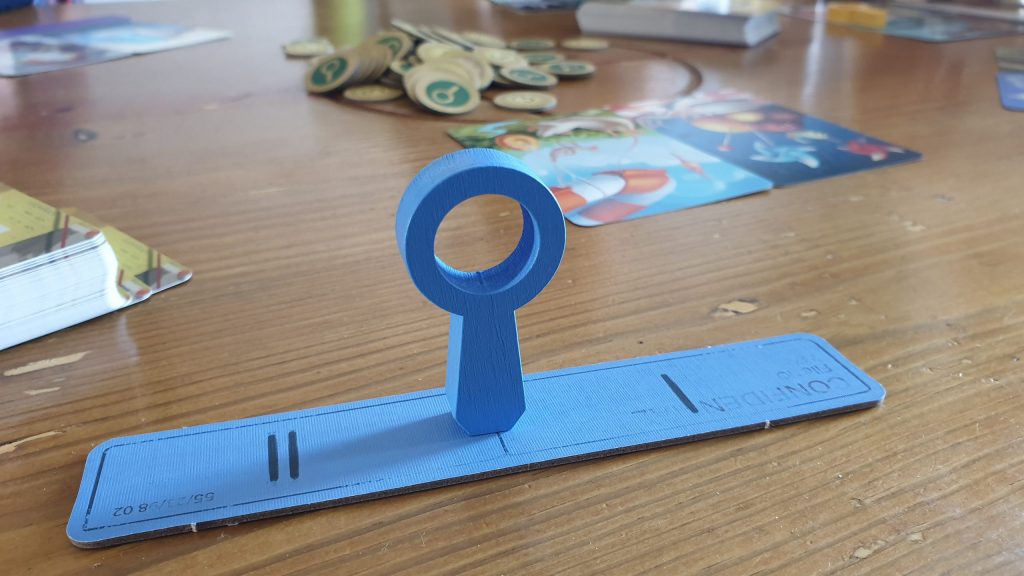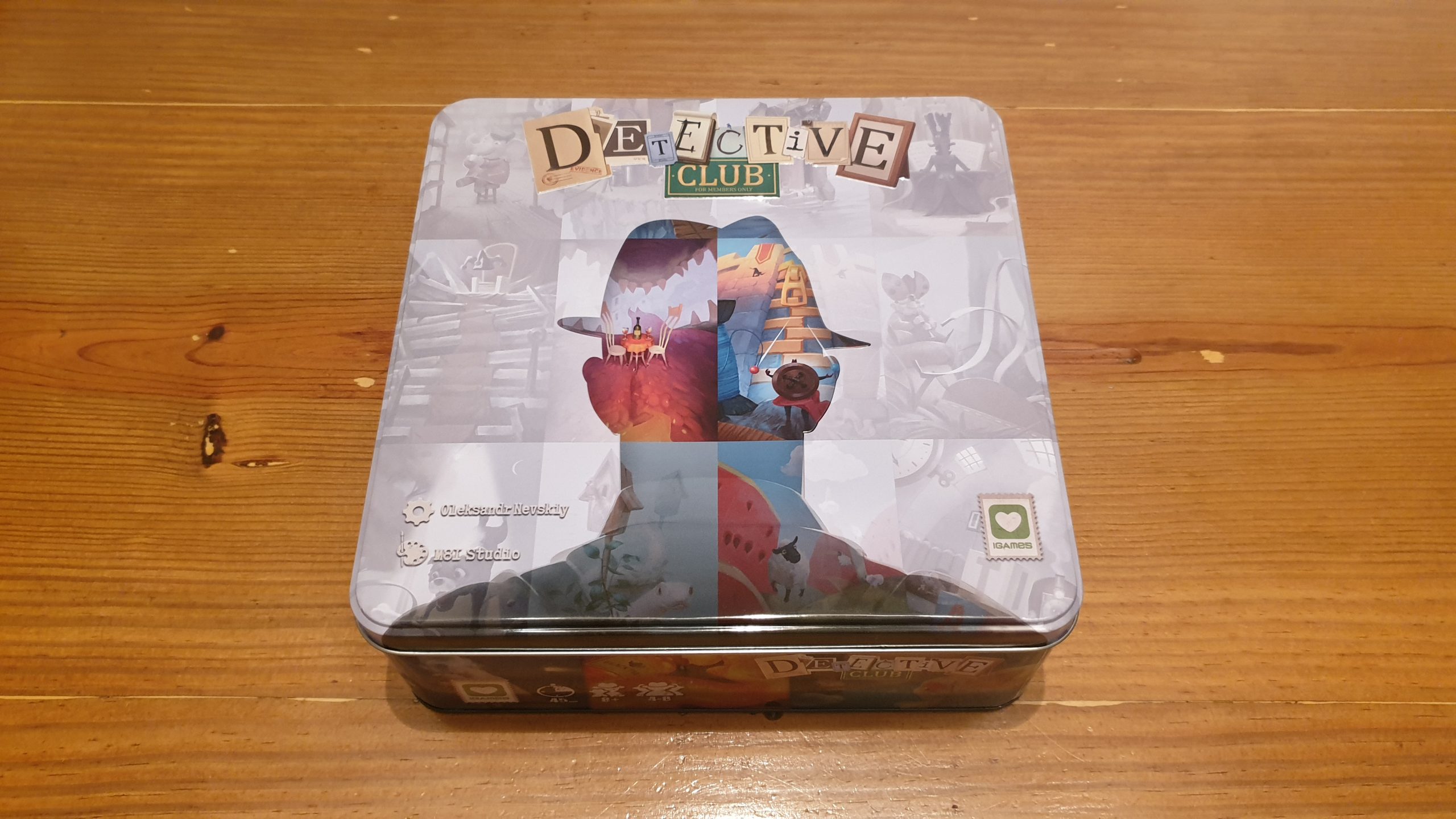Detective Club is a party game from publisher IGAMES, that features bluffing, deduction and a lot of abstract artwork. Designed by Oleksandr Nevskiy, the game sees 4 – 8 players spend around 45 minutes playing evidence cards and attempting to determine the conspirator from the detectives. In a sense the game is a mixture of Dixit and hidden traitor games like Spyfall. However, do these mix to create an entertaining experience? Let’s find out!
At the start of the game each player chooses a colour, taking the associated small player board and voting token. Played over a number of rounds, players will take turns being the clue giver. This is an overseer or games master type role. The other players will become detectives, though one will secretly be a conspirator. The active player takes the notepads, one for each of the other players. Consulting their cards the player chooses a word.
Before anything else happens the active player plays one of their cards into the center of the table – naturally being one that is related to the word. The word is then written onto all of the notepads except for one. The active player chooses whom to give the notepads to, effectively choosing the conspirator. Going clockwise from the active player each player plays one card from their hand they believe has a link to the word.
Once everyone has played one card, starting with the active player everyone plays a second card. Players put their cards next to their small player board with markers for their first and second card, allowing others to know which they choose first. Players always have 6 evidence cards to pick from, being dealt six at the start of the game and always drawing back up to 6 when playing cards. This means there is always a choice – though this won’t stop players attempting to bluff they had bad cards for the word.

When all cards are played, the active player reveals the word. Starting with the active player everyone then explains why they chose the cards that they did. After everyone has explained a vote occurs. Aside from the active player, in clockwise order, each player votes on whom the conspirator was – the player that didn’t initially get given the word. Detectives gain 3 points if they successfully guess the conspirator. The conspirator gains 5 points if 1 or fewer detectives guess them, and if this happens the active player gains 4. The active players job is to make it easy for the conspirator, hence this is how they gain points. The game continues until each player has had a turn at being the active player (increased to twice for 4 – 5 player games), at this point whomever has the most points wins!
The game works because the cards have many overlapping concepts. Be it water, animals, shapes or aspects like a type of transport. Combine this with the active player only getting points if the conspirator gets away with it and there is a rather interesting dynamic to the game. While other hidden traitor style games, such as The Chameleon, rely on the traitor player not finding out what the word is, the conspirator will find out the exact word before their explanation. This removes some of the stress of being on the spot. Some players love the stress and others are put off, with this approach seeming friendlier.
Some stress still remains which can change to the thrill of getting away with it. The active player does need to pick wisely though, often a meta can develop of who to pick. Picking a player early in the order and they’ll have far less time to come up with a story. At the same time if they are at the end of the player order, and they simply regurgitate what others have said, they still might be found out. Some players are naturally better at bluffing so perhaps they are a good option. If the group knows who is best though they can also become suspected or picked too often.
The Dixit like cards are weird and wonderful. They never show exactly what you need them too, yet they can work for so many different clue words. When the word is something simplistic like “animals” a selection of cards can be played. When going for something like “fluffy” though it opens up the possibility for cards featuring clouds, wispy food and more. The description stage from each player can be an interesting one, if they think outside the box like the artwork.

The artwork adorns large evidence cards, which are on decent card stock. While large they are still fairly easy to shuffle. Still, the amount can make attempting to shuffle the entire deck at once a little unwieldy. The player boards are simple but effective. Knowing which card a player decided to play first can sometimes give a lot away so this indicator is ideal. The point tokens are nice large cardboard tokens, which do the job. Alongside the artwork it is the chunky wooden voting magnifying glass shaped tokens that stand out as a rather nice component.
The biggest issue of Detective Club is determining the ideal player count. The game plays with 4, and entertainment can certainly be had. However, only 3 players at a time will be detectives or the conspirator. When not the conspirator you only have a 50:50 choice of whom the conspirator is. As soon as another player is added to the mix the percentage chance an individual is the conspirator drops and it feels like an achievement to guess the conspirator. At the other end of the spectrum, the way the scoring works makes it harder for the conspirator to gain points. Regardless of the player count the conspirator can only be outed by 1 player. This makes it easy to explain the game, with that always being the case. However, with above 6 this feels almost impossible. Even with the additional people there to potentially draw attention, there are also more people voting.
Detective Club has certainly managed to combine wonderful abstract artwork of games like Mysterium and use it within a hidden traitor like game. There is certainly no denying the quality of the stunning art that is on every single card. The game isn’t as confrontational as most hidden traitor titles and this friendly tone suits the game well. Despite the player count issue there is a solid amount of laughs and entertainment awaiting players. Though harder to get away as the conspirator at higher player counts it is still fun to play and the detectives still need to correctly guess. Therefore, with 5 players or above, Detective Club is a game I’ll turn to for a more chilled hidden traitor experience.
(Editor’s Note: Detective Club was provided to us by Asmodee for the review. The game is currently available from local board game stores, find your local store here.)

